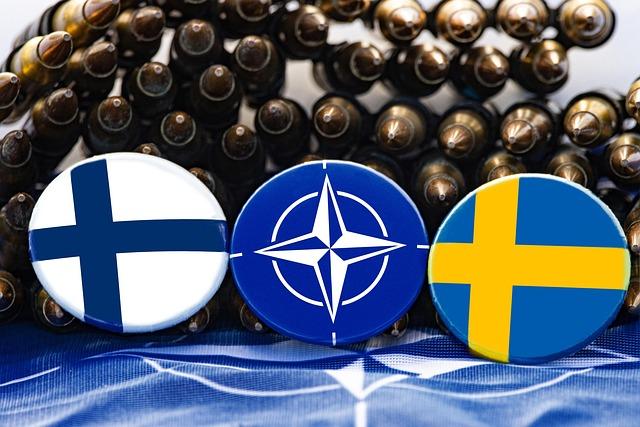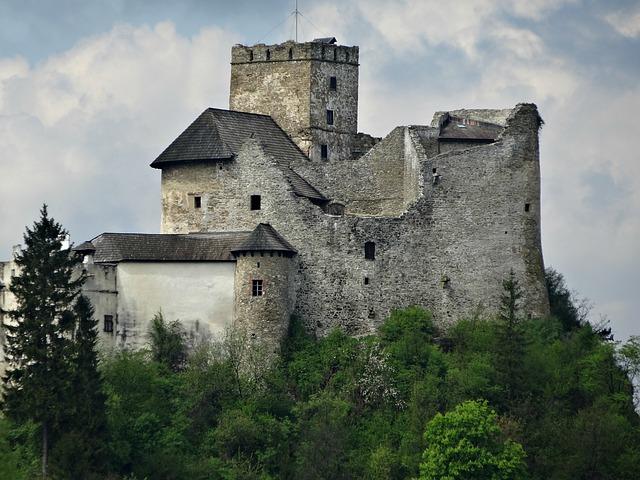PolandŌĆÖs Strategic Position: Navigating the Trans-Atlantic Defense Divide
As geopolitical tensions reshape the security landscape of Europe and its relations with the United States, Poland finds itself at the forefront of a critical defense paradigm. Positioned at the crossroads of Eastern and Western Europe,the nation has emerged as a pivotal player in trans-Atlantic defense discussions,balancing its historical ties with NATO allies against the backdrop of an evolving threat environment. This article delves into how Poland navigates the complexities of its defense commitments, the implications of its strategic partnerships, and the challenges it faces in an era characterized by heightened military scrutiny and necessity. By analyzing Poland’s unique position, we aim to shed light on how it navigates the delicate balance between regional security aspirations and broader trans-Atlantic alliances, ultimately shaping the future of defense cooperation on both sides of the Atlantic.
PolandŌĆÖs Geopolitical Role in Strengthening Trans-Atlantic Defense Cooperation
Poland has emerged as a pivotal player in the landscape of trans-Atlantic defense cooperation, acting as a critical link between Western Europe and the United States. This strategic positioning allows Poland to facilitate military partnerships, ensuring that NATOŌĆÖs eastern flank remains robust in the face of evolving security threats. Among its key contributions are:
- Hosting NATO Troops: Poland has welcomed a significant deployment of NATO forces, reinforcing the alliance’s presence in eastern Europe.
- Defense Spending: With a commitment to meeting NATOŌĆÖs defense investment guidelines, Poland has prioritized military modernization and capability enhancement.
- Regional Security Initiatives: Poland has initiated collaborative defense programs, such as the Three Seas Initiative, aimed at strengthening infrastructure and defense among Central and Eastern European nations.
In addition to these contributions,Poland plays a vital role in facilitating discussions on strategic defense policies that resonate across the Atlantic. The nationŌĆÖs involvement in multinational exercises and defense forums fosters an environment of cooperation and innovation among allied forces. Key aspects of Poland’s approach include:
| Aspects | Impact |
|---|---|
| Continuous Military Training | Enhances interoperability among NATO forces. |
| Cyber Defense Measures | Strengthens collective security against emerging threats. |
| Energy Security Initiatives | Reduces dependencies and promotes stability in the region. |

The Impact of NATOŌĆÖs Eastern Flank on PolandŌĆÖs Defense Strategy
The ongoing evolution of NATO’s Eastern Flank has significantly shaped Poland’s defense strategy, reflecting its geopolitical concerns and military aspirations. As a frontline state in the alliance, Poland recognizes the necessity of a robust defense posture that deters potential aggressors while enhancing regional security cooperation. Key elements of this strategy include:
- Increased Defense Spending: Poland has committed to raising its defense budgets to meet and exceed NATO’s guideline of 2% of GDP.
- Modernization of Armed Forces: The acquisition of advanced military equipment, including helicopters, drones, and missile defense systems, underscores PolandŌĆÖs intent to modernize its forces.
- Strengthening Allied Ties: Participation in joint exercises and hosting NATO troops reinforces PolandŌĆÖs role as a regional leader in collective defense.
Moreover, Poland’s strategic initiatives hinge on the necessity for comprehensive deterrence capabilities, ensuring readiness against hybrid threats and conventional military aggression. By fostering bilateral and multilateral defense partnerships, Poland aims to bolster military interoperability with NATO allies.The following table highlights Poland’s key defense partnerships and collaboration efforts:
| Contry/Organization | Collaboration Focus |
|---|---|
| United States | Joint military exercises, equipment provision, intelligence sharing |
| Germany | Integrated air defense systems, training and joint operations |
| NATO | Enhanced Forward Presence, collective defense strategies |

Balancing Act: PolandŌĆÖs Military Modernization and Its Implications for Regional Security
PolandŌĆÖs military modernization agenda has emerged as a cornerstone of its national strategy, aimed at enhancing both military capability and regional stability. with a significant increase in defense spending to meet NATO commitments, Poland is on a trajectory to become one of the most formidable military powers in Central Europe. Key components of this modernization program include:
- investment in Cutting-Edge Technology: The acquisition of advanced weaponry,including American-made F-35 fighter jets and cutting-edge missile defense systems,underscores Poland’s intent to bolster its air and ground defenses.
- Increased Defense Spending: Poland plans to allocate 3% of its GDP to defense, reinforcing its commitment to NATO and enhancing its operational readiness.
- Rapid Expansion of Military Forces: The establishment of new brigades and the revitalization of existing units aim to ensure rapid response capabilities in the face of potential threats.
The implications of Poland’s ambitious military upgrades are multifaceted. On one hand,they serve as a deterrent against potential aggressors in the region,fostering a climate of security among NATO allies. However, this modernization also raises concerns about escalating military tensions, particularly with Russia, which perceives PolandŌĆÖs advancements as a direct threat. The evolving dynamics can be illustrated in the table below, summarizing key elements of Poland’s military strategy alongside potential consequences for regional security:
| Military Strategy Element | Potential Impact on Regional security |
|---|---|
| Increased NATO Presence | Strengthened deterrence against aggression |
| Modernized Defense Systems | Enhanced defensive capabilities, but may provoke neighboring states |
| Joint Exercises with Allies | Improved interoperability and collective defense posture |

Fortifying Alliances: PolandŌĆÖs Engagement with the United States and NATO Partners
Poland’s position as a unique link between Eastern and Western Europe affords it a critical role in fortifying democratic values through alliances with the United States and NATO partners. With heightened security concerns stemming from Russian aggression, Poland has proactively reinforced its military commitments and operational capacities. This includes:
- Increased Defense Spending: Poland aims to achieve 2.5% of its GDP allocated to defense by 2030, reflecting a commitment to NATO obligations.
- Modernization of armed Forces: Initiatives such as acquiring advanced weapons systems from the U.S. showcase Poland’s drive to bolster its deterrence capabilities.
- hosting U.S.Troops: With a significant presence of American troops, Poland enhances interoperability and rapid response capabilities across NATO forces.
Furthermore, Poland’s collaboration extends beyond military capabilities; it embodies a strategic partnership that promotes stability and security across the region. Recent joint exercises and intelligence-sharing initiatives highlight the importance of unity among NATO members. Key elements of this engagement include:
| Collaboration Type | Key Examples |
|---|---|
| Joint Military Exercises | DEFENDER-Europe 21, Anakonda |
| Intelligence Sharing | Enhanced situational awareness with U.S. and NATO allies |
| Cybersecurity Cooperation | Joint initiatives to combat cyber threats |
As poland navigates its role in a shifting geopolitical landscape, its commitment to collective defense through robust alliances with the U.S. and NATO is more crucial than ever.This approach not only bolsters national security but also ensures a cohesive trans-Atlantic defense posture in addressing emerging threats.

recommendations for Enhancing PolandŌĆÖs Role as a Defense Bridge in Europe
Poland has the potential to play a pivotal role as a defense bridge in Europe, and several recommendations can fortify its position. First, enhancing military cooperation with NATO allies is essential. Poland should prioritize the establishment of joint military exercises and integrated operational plans that not only bolster regional security but also serve as a deterrent against potential aggressors. Strengthening Poland’s defense industry through strategic partnerships can elevate its capabilities while promoting technological advancements in defense systems. Collaborative initiatives can include:
- Joint training programs with neighboring countries.
- Increased defense spending focused on modernization of armed forces.
- Knowledge sharing through military attach├®s and exchange programs.
Moreover, to enhance its role, Poland should actively engage in diplomatic dialogues emphasizing energy security and cybersecurity within the EU. A comprehensive approach to defense that incorporates economic and social dimensions can attract investments and foster innovation.By leading initiatives on collective defense, Poland coudl establish a platform for details sharing among European nations regarding emerging hybrid threats. Key areas for focus could include:
| Area of Focus | Recommended Action |
|---|---|
| Energy Security | Progress of resilient energy supply chains. |
| Cybersecurity | Creation of a regional cyber defense task force. |
| Military Collaboration | Formation of a new defense pact with Baltic states. |
Closing Remarks
PolandŌĆÖs unique position as a key player in trans-Atlantic defense dynamics sheds light on the complex interplay between regional security needs and broader NATO commitments. As tensions persist along the Eastern European frontier, PolandŌĆÖs efforts to enhance its military capabilities and foster stronger alliances with both the united States and European partners underscore its strategic importance. The nationŌĆÖs ability to navigate these dual obligations not only reinforces its national security but also serves as a model for other countries facing similar dilemmas in an increasingly polarized global environment. As Poland continues to strengthen its role within NATO and the wider defense landscape, its outcomes will be closely watched, offering insights into the future of trans-Atlantic relations and collective security.
















